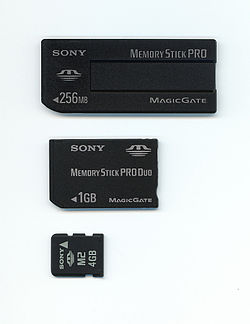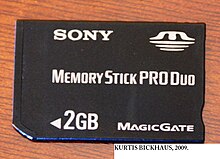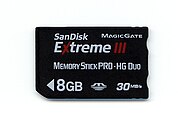How To Upload A Sony Memory Stick Duo How To Upload Photos From Sony Memory Stick Pro Duo
 | |
 From top to bottom: Memory Stick PRO, Memory Stick PRO Duo, Memory Stick Micro (M2) | |
| Media type | Flash memory bill of fare |
|---|---|
| Chapters | 128 MB (Original) 32 GB (PRO series) ii TB (Xc serial) |
| Developedby | Sony |
| Extendedto | Memory Stick PRO, Retentiveness Stick Duo, Retention Stick PRO Duo, Memory Stick PRO-HG Duo, and Retention Stick Micro |
The Memory Stick is a removable wink memory carte format, originally launched by Sony in late 1998.[1] In addition to the original Memory Stick, this family unit includes the Retention Stick PRO, a revision that allows greater maximum storage capacity and faster file transfer speeds; Memory Stick Duo, a minor-form-gene version of the Memory Stick (including the PRO Duo); the fifty-fifty smaller Memory Stick Micro (M2), and the Memory Stick PRO-HG, a loftier speed variant of the PRO to be used in high-definition video and still cameras.
Equally a proprietary format, Sony exclusively used Memory Stick on its products in the 2000s such as Cyber-shot digital cameras, Handycam digital camcorders, WEGA and Bravia Telly sets, VAIO PCs, early on Walkman digital sound players, and the PlayStation Portable handheld game panel,[2] with the format beingness licensed to a few other companies early on in its lifetime. With increasing popularity of SD bill of fare, in 2010 Sony started to back up the SD card format, which was seen as a Sony loss in the memory-card format war.[3] Despite this, Sony continued to support Memory Stick on certain devices.
History [edit]
The original Retentiveness Stick, which was launched in October 1998, was available in capacities up to 128 MB.[iv]
In October 1999, Sony licensed the technology to Fujitsu, Aiwa, Sanyo, Sharp, Pioneer and Kenwood, in a bid to avert a repetition of the Betamax failure.[5] Other companies were too licensees to the format. Some early examples of Retention Stick usage by 3rd-party companies include Sharp's MP3 players, Alpine's in-dash players, and Epson's printers.[six]
Initially the format had a lukewarm reception, only information technology soon increased in popularity, peculiarly after the licensing deal. In spring 2001, Memory Stick attained 25% market share (against CompactFlash's 40% and SmartMedia'southward 32%), upwardly from seven% a year earlier. By May 2001, total shipment of Retentivity Stick units surpassed 10 one thousand thousand.[half-dozen]
Still the SD bill of fare, jointly adult past Toshiba, Panasonic and SanDisk, became widely pop among companies and soon became the most popular flash format – past November 2003 it held 42% market share in the United states of america, ahead of CompactFlash'due south 26% and Retentivity Stick with 16%.[7] Eventually Sony itself became the only company to support the format. Sony was ofttimes criticized for the Retentivity Stick, as they were deemed to exist expensive compared to other formats.[eight]
Every bit of January 2010[update], it appeared that Sony had begun to combine support for SD/SDHC and Memory Stick formats in their products. All digital cameras and camcorders appear by Sony at the 2010 Consumer Electronics Show could use SD and SDHC cards also as Retention Sticks.[ix] [10] [11] [12] [thirteen] Furthermore, Sony appear the release of its own line of SD cards.[14] Many claimed this development equally the end of the format war betwixt Memory Stick and SD card. Nonetheless, Sony did non abandon the format at this time, and indicated that information technology would go on development of the format for the foreseeable future. A prime number example was the evolution of WiFi transfers through a special Retention Stick PRO-Duo which was nonetheless in development every bit of 2011[update].[xv] [16] [17] [18] [xix] [20] [21]
Sony's first significant migration away from Memory Stick did non come until 2019, when it introduced the α7R IV full-frame mirrorless interchangeable-lens camera without Memory Stick back up, opting instead for dual SDXC slots.[22]
Retentivity Stick cards were well-nigh entirely produced by Sony itself. SanDisk and Lexar were among the few third-party Memory Stick producers.
Applications [edit]
Typically, Memory Sticks are used equally storage media for a portable device, in a course that can easily be removed for access by a personal computer. For instance, Sony digital meaty cameras utilize Memory Stick for storing image files. With a Memory Stick-capable retentivity card reader a user can copy the pictures taken with the Sony digital camera to a computer. Sony typically included Memory Stick reader hardware in its first-party consumer electronics, such as digital cameras, digital music players, PDAs, cellular phones, the VAIO line of laptop computers, Television receiver sets under the WEGA and Bravia names, and Sony's handheld gaming device, the PlayStation Portable.
A special Memory Stick can exist inserted in the hindquarters[23] of Sony's AIBO robot pet, to enable the use of Aiboware—software intended for use on AIBOs. The Sticks include a re-create protection mechanism used by the robot, allowing users to write programs. These are referred to as programmable or programming. Only 8 MB and sixteen MB versions are available.
Formats and class factors [edit]
Memory Sticks include a wide range of actual formats, including three different course factors.
Retentiveness Stick [edit]

The original Memory Stick

Sony Memory Stick with MagicGate
The original Retention Stick is approximately the size and thickness of a stick of chewing gum. It was available in capacities from 4 MB to 128 MB (i MB = one meg bytes). It was available both with and without MagicGate back up. The MagicGate-capable memory sticks were white-colored, while the standard version was purple. The original Memory Stick is no longer manufactured.
Memory Stick Select [edit]

Lexar 256 MB Memory Stick Select with retention switch
In response to the storage limitations of the original Retentiveness Stick, Sony introduced the Memory Stick Select at CES 2003 on January 9.[24] The Memory Stick Select contained ii separate 128 MB partitions which the user could switch between using a concrete switch on the menu. This solution was fairly unpopular, simply it did give users of older Retentiveness Stick devices more than capacity. Its physical size remained the same equally the original Memory Stick.
Memory Stick PRO [edit]
The Retentiveness Stick PRO, introduced on Jan 9, 2003 as a articulation endeavor between Sony and SanDisk,[25] would be the longer-lasting solution to the infinite problem. Nearly devices that use the original Retentivity Sticks back up both the original and PRO sticks since both formats have identical form factors. Some readers that were not compatible could be upgraded to Memory Stick PRO support via a firmware update. Memory Stick PROs have a marginally higher transfer speed and a maximum theoretical chapters of 32 GB,[26] although GB-sized capacities of more than 2GB are only bachelor in the PRO Duo grade factor.[27] High Speed Retentivity Stick PROs are available, and newer devices back up this high-speed mode, allowing for faster file transfers. All Retentiveness Stick PROs larger than 1 GB support this high-speed way, and Loftier Speed Retentivity Stick PROs are backwards-compatible with devices that don't support the high-speed mode. High-capacity Retentivity Sticks such as the 4 GB versions are expensive compared to other types of wink memory such every bit SD cards and CompactFlash. As of 2020[update], 512 MB Memory Stick PRO tin can exist bought.
Retentiveness Stick Duo [edit]
The Memory Stick Duo was developed in response to Sony'southward demand for a smaller flash memory carte for pocket-sized digital cameras, jail cell phones and the PlayStation Portable (the subsequently of which supported the Memory Stick PRO Duo variant). Information technology is slightly smaller than the competing Secure Digital (SD) format and roughly two thirds the length of the standard Retentiveness Stick course gene, but costs more. Retention Stick Duos are available with the same features as the larger standard Memory Stick, bachelor with and without high speed mode, and with and without MagicGate support. The Memory Stick PRO Duo has replaced the Memory Stick Duo due to its 128 MB size limitation, only has kept the aforementioned form cistron every bit the Duo.

Memory Stick Duo Adaptor and Memory Stick PRO Duo
A unproblematic adapter allows Memory Stick Duo to be used in devices designed to accept the original Retentivity Stick form factor.
Retention Stick PRO Duo [edit]

A Sony Memory Stick PRO Duo (ii GB)
The Memory Stick PRO Duo (MSPD) speedily replaced the Memory Stick Duo due to the Duo's size limitation of 128 MB and slow transfer speed. Memory Stick PRO Duos are available in all the same variants as the larger Memory Stick PRO, with and without High Speed mode, and with and without MagicGate back up.
Sony has released different versions of Memory Stick PRO Duo. A Memory Stick PRO Duo with MagicGate was released equally a 512 MB stick.[ commendation needed ] Additionally, a xvi GB version on March 2008 and some other a 32 GB version on August 21, 2009.[28] In 2009, Sony and SanDisk likewise announced the joint evolution of an expanded Retentivity Stick PRO format tentatively named "Memory Stick PRO Format for Extended Loftier Capacity".[29] Sony has since finalized the format and released its specification nether the new name, Memory Stick Ninety (see beneath).[thirty]
Retentiveness Stick PRO-HG Duo [edit]

On December xi, 2006, Sony, together with SanDisk, announced the Retentiveness Stick PRO-HG Duo. While only series and 4-scrap parallel interfaces are supported in the Memory Stick PRO format, an 8-flake parallel interface was added to the Retentiveness Stick PRO-HG format. Likewise, the maximum interface clock frequency was increased from 40 MHz to threescore MHz. With these enhancements, a theoretical transfer rate of 480 Mbit/s (lx MB/s) is achieved, which is three times faster than the Memory Stick PRO format.
Memory Stick Micro (M2) [edit]

In a joint venture with SanDisk, Sony released a new Memory Stick format on February 6, 2006. The Retentivity Stick Micro (M2) measures 15 × 12.5 × 1.2 mm (roughly ane-quarter the size of the Duo) with 64 MB, 128 MB, 256 MB, 512 MB, 1 GB, 2 GB, four GB, 8 GB, and 16 GB capacities available. The format has a theoretical limit of 32 GB and maximum transfer speed of 160 Mbit/s. All the same, as with the PRO Duo format, it has been expanded through the XC series as Memory Stick Xc Micro and Retentivity Stick Ninety-HG Micro, both with the theoretical maximum capacity of ii TB.[30] [31]
The M2 comes with an adapter, much like the Duo Sticks, to ensure physical compatibility with Memory Stick PRO devices. Yet, not all devices with a PRO slot are compatible with the M2/Adapter combination, as the firmware of older devices don't back up the higher capacity of some M2 cards. One example is certain Sony CLIÉ PDAs which don't support cards larger than 2 GB.[32]
Sony announced on June ane, 2009, that M2 support in Sony Ericsson phones would exist dropped in favor of microSD.[33]
The Sony DSC-RX0 Mark 2 made a revived usage of M2 slots.
Memory Stick XC [edit]
On January seven, 2009, SanDisk and Sony appear the Memory Stick XC format (tentatively named "Memory Stick Format Serial for Extended High Chapters" at the time).[34] [35] The Memory Stick XC has a maximum theoretical 2 TB capacity, 64 times larger than that of the Memory Stick PRO Duo which is limited to 32 GB. XC series has the same grade factors as PRO serial, and supports MagicGate content protection technology as well as Access Command function as PRO series does. In line with the rest of the industry, the XC series uses the newer exFAT file system due to size and formatting limitations of FAT/FAT16/FAT32 filesystems used in the PRO series.[36] [37] A maximum transfer speed of 480 Mbit/s (60 Mbyte/s) is accomplished through 8-flake parallel information transfer.[38] No Memory Stick Ninety cards were released to the market, likely due to domination of SD cards; its equivalent hither is named SDXC and eventually became more successful than any other exFAT-based memory carte format.
Memory Stick PRO-HG Duo HX [edit]
Sony appear the release of the Memory Stick PRO-HG Duo HX on May 17, 2011, which was considered the fastest carte e'er fabricated by the manufacturer. It measures 20 × 31 × 1.6 mm, with 8 GB, sixteen GB, or 32 GB versions available. Also, the format offers a maximum transfer speed of 50 MB/s.[39]
Marking 2 certification [edit]
As of early on 2008, Mark 2-certified versions of the Memory Stick PRO Duo became available. The Marking 2 designation indicates the Memory Stick is suitable for use with AVCHD recording products or other faster Memory Stick enabled devices past providing appropriate minimum write performance.[twoscore]
See also [edit]
- CompactFlash Card
- Comparison of retentiveness cards
- Format war
- MultiMediaCard
- SD Card
- SmartMedia Card
- SxS
- xD Picture Carte du jour
References [edit]
- ^ "Sony Global – Printing Release – Sony Announces 'Retention Stick' Recordable IC Retentiveness Bill of fare Products New Format Supports Recording and Playback of Audio/Video Content". Sony.internet (Printing release). Retrieved November 13, 2011.
- ^ "The worst storage mediums of all fourth dimension - Page iii of 4 - ExtremeTech". extremetech.com. May fifteen, 2014.
- ^ "The Beginning of the End of Retentivity Stick? Hope So!". technologizer.com. Jan vi, 2010.
- ^ In this article the unit symbol 'MB' is used to mean 1000^two bytes (one megabyte)
- ^ "Sony To License Memory Stick to 6 Firms". dpreview.com.
- ^ a b "Archived re-create". www.simmtester.com. Archived from the original on July 17, 2001. Retrieved Jan 25, 2022.
{{cite web}}: CS1 maint: archived copy as title (link) - ^ Taub, Eric A. (February 2, 2004). "TECHNOLOGY; Memory Evolution: Survival of the Smallest". The New York Times.
- ^ "Behind the smiles at Sony". The Economist. March x, 2005. Retrieved December 29, 2021.
- ^ "Sony.com". News.sel.sony.com. January 6, 2010. Retrieved November xiii, 2011.
- ^ "Sony.com". News.sel.sony.com. January 6, 2010. Retrieved November 13, 2011.
- ^ "Sony.com". News.sel.sony.com. January 6, 2010. Retrieved November xiii, 2011.
- ^ "Sony.com". News.sel.sony.com. Jan 6, 2010. Retrieved November 13, 2011.
- ^ "Sony.com". News.sel.sony.com. January 6, 2010. Retrieved November 13, 2011.
- ^ "Sony.com". News.sel.sony.com. January six, 2010. Retrieved November 13, 2011.
- ^ Taub, Eric A. (January 7, 2010). "Sony's Retention Stick: Bowing to Reality". The New York Times . Retrieved May 12, 2010.
- ^ Velocity. "Forbes.com". Forbes . Retrieved November 13, 2011.
- ^ "FT.com". Blogs.ft.com. January vii, 2010. Retrieved Nov 13, 2011.
- ^ "Endgadget.com". Engadget.com. January 6, 2010. Retrieved Nov xiii, 2011.
- ^ "IEEE.org". Spectrum.ieee.org. Jan 7, 2010. Retrieved Nov 13, 2011.
- ^ McCracken, Harry (January 7, 2010). "PCworld.com". PCworld.com . Retrieved November 13, 2011.
- ^ "APCMAG.com". APCMAG.com . Retrieved November xiii, 2011.
- ^ "Sony introduces the a7R IV with 61 Megapixel total-frame sensor". Digital Photography Review. July sixteen, 2019. Retrieved July sixteen, 2019.
- ^ "CBS News, 48 Hours – AIBO, The Digital Wonder Canis familiaris: Sony Spends Millions On Robotic Canine". Cbsnews.com. February eleven, 2009. Retrieved Nov 13, 2011.
- ^ "Sony Memory Stick Pro and Select". dpreview.com.
- ^ "Sony.net". Sony.net . Retrieved November 13, 2011.
- ^ In this article the unit symbol 'GB' is used to mean 1000^3 bytes (1 gigabyte)
- ^ "Sony Compatibility Chart - Digital Nevertheless Photographic camera". Sony-asia.com . Retrieved April 5, 2021.
- ^ "Crunchgear.com". Crunchgear.com. August 21, 2009. Retrieved November xiii, 2011.
- ^ "SanDisk, Sony to Aggrandize Memory Stick PRO, Retention Stick Micro Formats". Nikkei Business Publications. January viii, 2009. Retrieved January 5, 2010.
- ^ a b MacManus, Christopher (August 5, 2009). "Sony Finalizes Backwards Compatible Retentiveness Stick Xc With 2TB Maximum Chapters". Sonyinsider.com . Retrieved Jan 5, 2010.
- ^ In this commodity the unit symbol 'TB' is used to hateful one thousand^4 bytes (1 terabyte)
- ^ "Sony Compatibility Chart – Clie Handhelds". Sony-asia.com . Retrieved November 13, 2011.
- ^ "Trusted Review – Sony Ericsson Dropping Memory Stick Micro". Trustedreviews.com . Retrieved November 13, 2011.
- ^ "Sandisk and Sony to expand "Retention stick pro" and "Retentiveness stick micro" formats". SanDisk. January 7, 2009. Retrieved Baronial 12, 2009.
- ^ Christopher MacManus. "Sonyinsider.com". Sonyinsider.com . Retrieved November 13, 2011.
- ^ "Windows FAT32 Formatting". Microsoft. Retrieved June 28, 2012.
- ^ "SanDisk exFAT KB". Kb.sandisk.com . Retrieved June 28, 2012.
- ^ "Oss-formats.org". Oss-formats.org . Retrieved November 13, 2011.
- ^ "Sony United kingdom of great britain and northern ireland - Press Centre". Presscentre.sony.co.uk . Retrieved December 29, 2021.
- ^ "Sony's new 16GB Memory Stick Pro Duo media [...] Mark2 Certification". News.sel.sony.com. January 6, 2008. Retrieved November thirteen, 2011.
External links [edit]
- Sony's official Ane Stop Site for Formats, with some specifications of the electrical interface.
- Retentivity Stick products at Sony Singapore.
- SanDisk and Sony develop "Memory Stick Micro" (M2) format – SanDisk/Sony press release, September 30, 2005.
- SanDisk and Sony denote "Memory Stick Pro-HG" (HG) format – Dec ane, 2006.
- Complete Retentiveness Stick® Media Compatibility Information for Sony® Digital Cameras Sony eSupport July 2011.
How To Upload A Sony Memory Stick Duo How To Upload Photos From Sony Memory Stick Pro Duo,
Source: https://en.wikipedia.org/wiki/Memory_Stick
Posted by: renoofuld1952.blogspot.com


0 Response to "How To Upload A Sony Memory Stick Duo How To Upload Photos From Sony Memory Stick Pro Duo"
Post a Comment